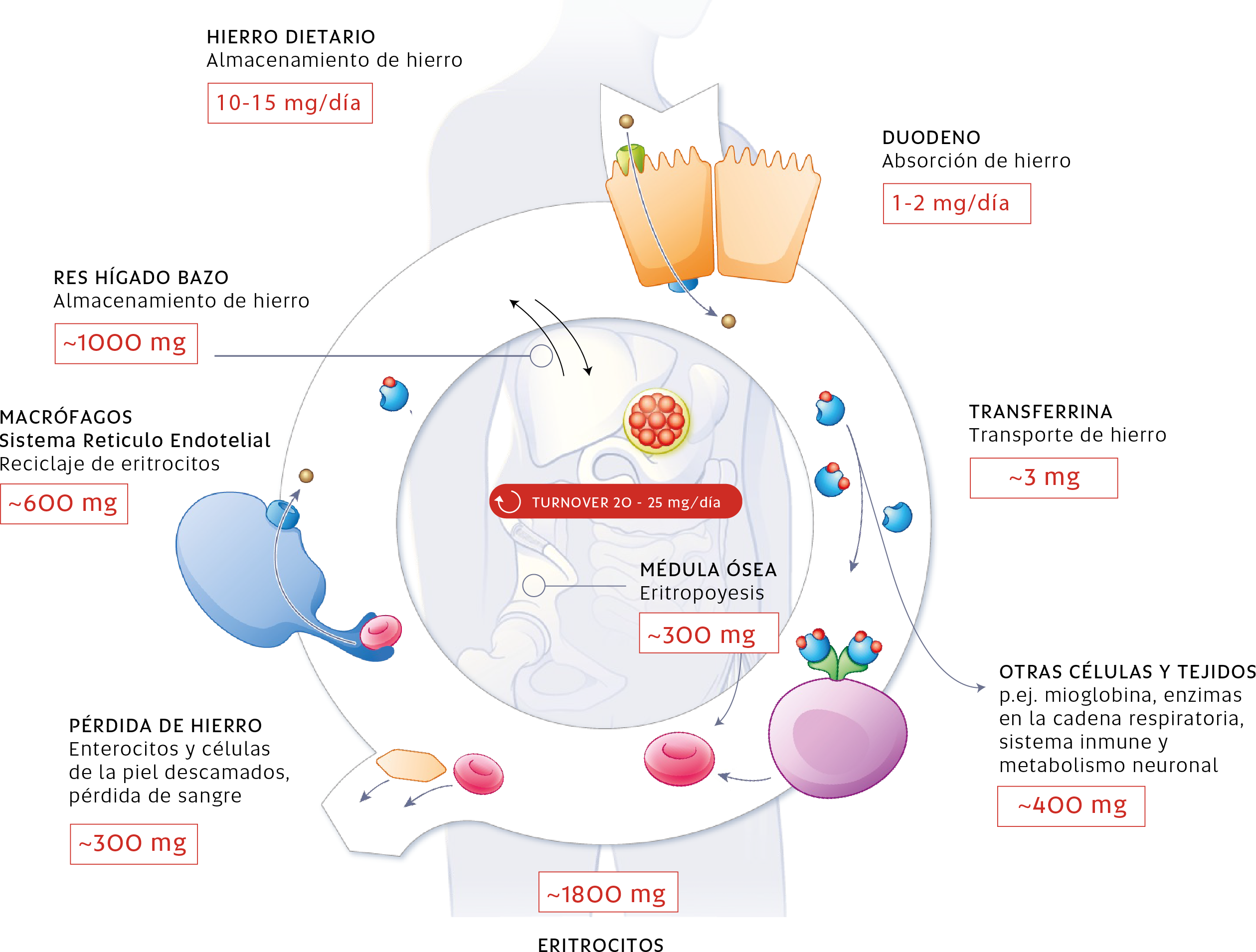Metabolismo del hierro
El metabolismo del hierro es un proceso sumamente eficiente, ya que la mayor parte del hierro necesario para la eritropoyesis es reciclado por los macrófagos a partir de glóbulos rojos envejecidos o dañados.
La gestión y la administración del hierro están estrechamente reguladas para garantizar un equilibrio adecuado entre la oferta y la demanda de este mineral. Las necesidades diarias de hierro se cubren mediante su captación por los enterocitos (1-2 mg), por los macrófagos que lo reciclan (20-25 mg) y por los tejidos de almacenamiento. La ingesta alimentaria debe cubrir las necesidades fisiológicas normales de una dieta equilibrada 5, 10
No obstante, en ocasiones es necesario un aporte adicional de hierro para satisfacer una mayor demanda de hierro o para compensar pérdidas de hierro, como ocurre durante el embarazo, la lactancia, la infancia, la pubertad o las hemorragias (por ejemplo, durante la menstruación). En tales situaciones, como pérdida crónica de sangre o incremento de la eritropoyesis, puede ser necesaria la administración de suplementos de hierro.5
El metabolismo del hierro consta de varios procesos importantes10 :
- Absorción del hierro en el duodeno.
- Transporte del hierro a las células y tejidos.
- Almacenamiento del hierro en forma de ferritina
- Reciclaje del hierro tras la degradación eritrocitaria.
Representación esquemática de la transformación del hierro

Referencias
- Clénin GE. The treatment of iron deficiency without anaemia (in otherwise healthy persons). Swiss Med Wkly. 2017;147:w14434
- Musallam KM, Taher AT. Iron deficiency beyond erythropoiesis: should we be concerned? Curr Med Res Opin. 2018;34(1):81–93.
- Doom JR. Striking while the iron is hot: Understanding the biological and neurodevelopmental effects of iron deficiency to optimize intervention in early childhood. Curr Pediatr Rep. 2015;2(4):291–298
- Worldwide prevalence of anaemia 1993–2005. WHO The global prevalence of anaemia in 2011. Geneva: World Health Organization 2015
- Lopez A et al. Iron deficiency anaemia. Lancet 2016;387(10021):907–16
- Herklotz R and Huber A. Labordiagnose von Eisenstoffwechselstörungen. Schweiz Med Forum 2010;10(30–31):500–507
- Clénin et al. The treatment of iron deficiency without anaemia (in otherwise healthy persons). Swiss Med Wkly. 2017 Jun14;147:w14434
- Hercberg S, Preziosi P, Galan P. Iron deficiency in Europe. Public Health Nutr 2001; 4: 537–545
- Chrobak C et al. Iron homeostasis in inflammation: a single centre prospective observational study in medical inpatients. Swiss Med Wkly. 2017;147:w14431
- Muckenthaler MU et al. A red carpet for iron metabolism. Cell 2017;168(3):344–361
- Dignass A et al. Limitations of Serum Ferritin in Diagnosing Iron Deficiency in Inflammatory Conditions. Int J Chronic Dis. 2018 Mar 18;2018:9394060
- Crichton RR et al. Iron therapy with special emphasis on intravenous administration. UNI-MED 2008, 4th Edition, chapter 3
- Huch R and Breymann C. Anämie in Schwangerschaft und Wochenbett. UNI-MED 2005, chapt. 3, p. 35
- Hunt JR. High-, but not low-bioavailability diets enable substantial control of women’'s iron absorption in relation to body iron stores, with minimal adaptation within several weeks, The American Journal of Clinical Nutrition, Volume 78, Issue 6, 1 December 2003, Pages 1168–1177
- Hurrell R, Egli I. Iron bioavailability and dietary reference values. Am J Clin Nutr. 2010;91(5):1467S–1467S
- Crichton R et al. Iron Therapy – With Special Emphasis on Intravenous Administration, 4th edition, UNI-MED, 2008, chapt. 2, p. 19–20
- Finch CA, Bellotti V, Stray S, Lipschitz DA, Cook JD, Pippard MJ, Huebers HA. Plasma ferritin determination as a diagnostic tool. West J Med 1986;145:657–663.
- Douglas B. Kell and Etheresia Pretorius. Serum ferritin is an important inflammatory disease marker, as it is mainly a leakage product from damaged cells. Metallomics, 2014,6, 748.
- T. N. Tran, S. K. Eubanks, K. J. Schaffer, C. Y. J. Zhou and M. C. Linder, Secretion of ferritin by rat hepatoma cells and its regulation by inflammatory cytokines and iron, Blood, 1997, 90, 4979–4986.
- L. A. Cohen, L. Gutierrez, A. Weiss, Y. Leichtmann- Bardoogo, D. L. Zhang, D. R. Crooks, R. Sougrat, A. Morgenstern, B. Galy, M. W. Hentze, F. J. Lazaro, T. A. Rouault and E. G. Meyron-Holtz, Serum ferritin is derived primarily from macrophages through a nonclassical secretory pathway. Blood 2010 116:1574-1584; doi: https://doi.org/10.1182/blood-2009-11-253815
- Cappellini MD et al. Iron deficiency across chronic inflammatory conditions: international expert opinion on definition, diagnosis, and management. Am J Hematol. 2017; 92(10):1068–1078
- Martius et al. Eisenmangel ohne Anämie – ein heisses Eisen? Nicht hämatologische Auswirkungen des Eisenmangels: Welche sind belegt, wann kommen sie zum Tragen? Schweiz Med Forum 2009;9(15–16):294–299
- Verdon F et al. Iron supplementation for unexplained fatigue in non-anaemic women: double blind randomized placebo controlled trial. BMJ 2003, 326: 1124–1126
- Cornuz J et al. Fatigue: a practical approach to diagnosis in primary care. 2006, CMAJ, 174(6)
- Favrat B et al. Evaluation of a single dose of ferric carboxymaltose in fatigue, iron-deficient women–PREFER a randomized, placebo-controlled study. PLoS One 2014;9(4):e94217
- Houston BL et al. Efficacy of iron supplementation on fatigue and physical capacity in non-anaemic iron-deficient adults: a systematic review of randomized controlled trials. BMJ Open 2018 8(4):e019240
- Yokoi K et al. Iron deficiency without anaemia is a potential cause of fatigue: meta-analyses of randomized controlled trials and cross-sectional studies. Br J Nutr. 2017 117(10):1422–1431
- Murray-Kolb LE, Beard JL. Iron treatment normalizes cognitive functioning in young women. On J Clin Nutr 2007, 85: 778
- Low MS et al. Daily iron supplementation for improving anaemia, iron status and health in menstruating women. Cochrane Database Syst Rev. 2016 Apr 18;4:CD009747
- Geng F et al. Impact of fetal-neonatal iron deficiency on recognition memory at two months of age. J Pediatr. 2015; 167(6):1226–1232
- Berglund SK et al. Effects of iron supplementation of low-birth-weight infants on cognition and behavior at 7 years: a randomized controlled trial. Pediatr Res. 2018;83(1–1):111–118
- Allen RP et al. Evidence-based and consensus clinical practice guidelines for the iron treatment of restless legs syndrome/Willis-Ekbom disease in adults and children: an IRLSSG task force report. Sleep Med. 2018, 41, 27–44
- Ferric carboxymaltose in patients with restless legs syndrome and nonanemic iron deficiency: a randomized trial. Mov Disord. 2017;32(10):1478–1482
- Kantor J et al. Decreased serum ferritin is associated with alopecia in women. J Invest Dermatol 2003;121:985
- Deloche C et al. Low iron stores: a risk factor for excessive hair loss in non-menopausal women. Eur J Dermatol 2007;17:507–512
- Martines-Torres C et al. Effect of exposure to low temperature on normal and iron-deficient subjects. On J Physiol 1984, 246: R380–R383
- Scott L J. Ferric carboxymaltose: a review in iron deficiency. Drugs 2018;78(4):479–493
- Information for Healthcare professionals Ferinject®: www.swissmedicinfo.ch
- Geisser P. Safety and efficacy of iron(III)-hydroxyde polymaltose complex / a review of over 25 years experience. Arzneimittelforschung 2007;57(6A):439–52
- Geisser P. The pharmacology and safety profile of ferric carboxymaltose (Ferinject®): structure/reactivity relationships of iron preparations. Port J Nephrol Hypert 2009:23(1):11–16





